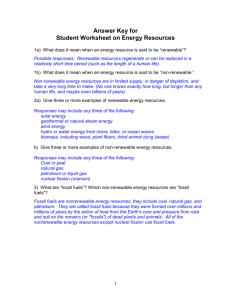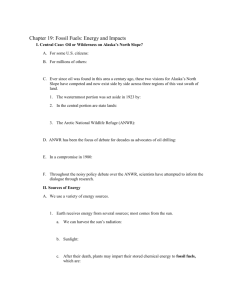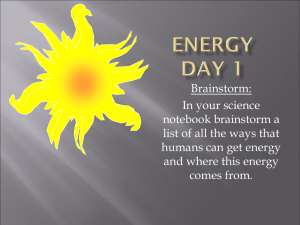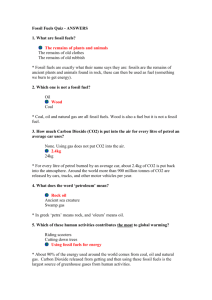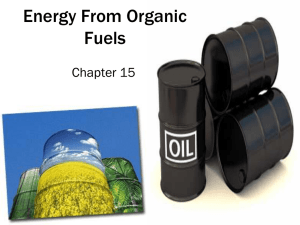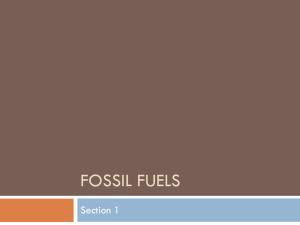Study Tools:
advertisement
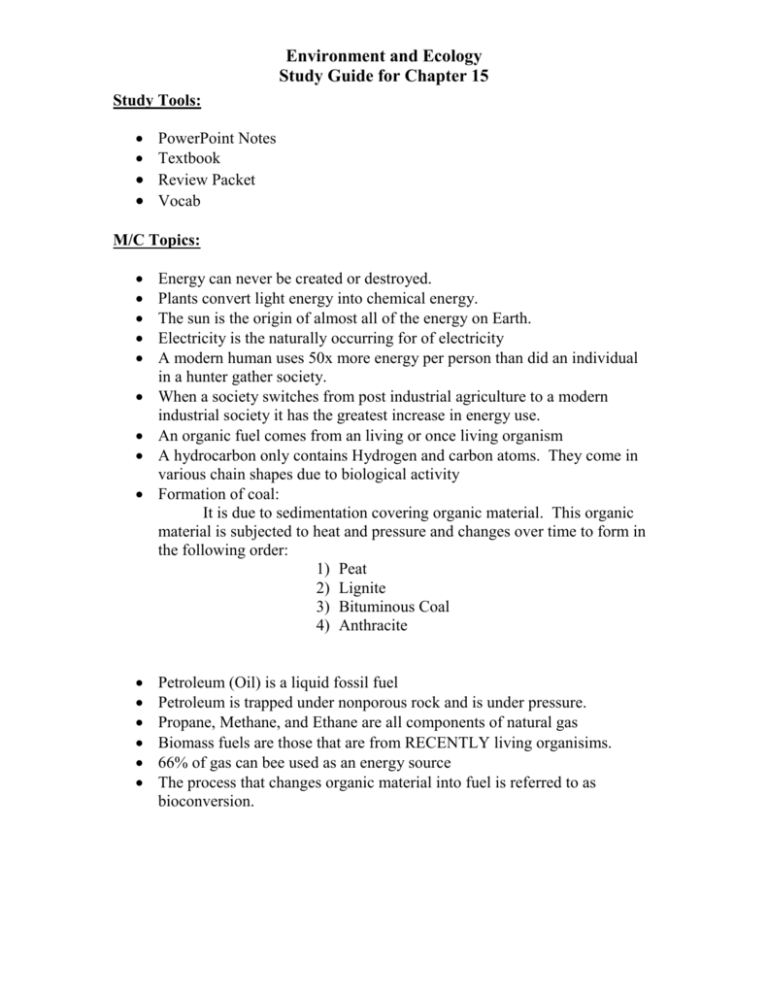
Environment and Ecology Study Guide for Chapter 15 Study Tools: PowerPoint Notes Textbook Review Packet Vocab M/C Topics: Energy can never be created or destroyed. Plants convert light energy into chemical energy. The sun is the origin of almost all of the energy on Earth. Electricity is the naturally occurring for of electricity A modern human uses 50x more energy per person than did an individual in a hunter gather society. When a society switches from post industrial agriculture to a modern industrial society it has the greatest increase in energy use. An organic fuel comes from an living or once living organism A hydrocarbon only contains Hydrogen and carbon atoms. They come in various chain shapes due to biological activity Formation of coal: It is due to sedimentation covering organic material. This organic material is subjected to heat and pressure and changes over time to form in the following order: 1) Peat 2) Lignite 3) Bituminous Coal 4) Anthracite Petroleum (Oil) is a liquid fossil fuel Petroleum is trapped under nonporous rock and is under pressure. Propane, Methane, and Ethane are all components of natural gas Biomass fuels are those that are from RECENTLY living organisims. 66% of gas can bee used as an energy source The process that changes organic material into fuel is referred to as bioconversion. Environment and Ecology Study Guide for Chapter 15 Matching Terms: Biomass Fuels Fuel Bituminous coal Anthracite coal Lignite Hydrocarbons Petroleum Fossil Fuels Organic Fuels Natural Gas Bioconversion Peat Test is this Friday (Nov. 9th) Hope this helps! Good Luck! -Mr. Holland Environment and Ecology Study Guide for Chapter 15 Section Review 15.1 Complete the following. 1. Name five forms of energy. 2. How is electricity commonly generated? 3. What are organic fuels? 4. What is a hydrocarbon? 5. Name three kinds of hydrocarbons. 6. What is a fossil fuel? 7. From where is the energy in a fossil fuel derived? 8. What are three kinds of fossil fuels? Environment and Ecology Study Guide for Chapter 15 Section Review 15.2 Complete the following. 1. How did coal form? 2. List and briefly describe the three types of coal. a. b. c. 3. What is peat? 4. Why is peat not the best source of fuel? 5. What are the stages of coal formation? 6. Which type of coal is best for fuel? Explain. Environment and Ecology Study Guide for Chapter 15 Section Review 15.3 Complete the following. 1. Name three types of fossil fuels and the states of matter in which they occur naturally. 2. Briefly describe the process by which petroleum formed. 3. How is petroleum extracted? 4. Why is petroleum such an important resource? 5. What mixture of gases makes up natural gas? 6. Where is natural gas often found? 7. Why are appliances that use natural gas considered to be more energy-efficient? Environment and Ecology Study Guide for Chapter 15 Section Review 15.4 Complete the following. 1. What are the main problems associated with the use of fossil fuels? 2. How does the burning of fossil fuels threaten the environment? 3. What is a biomass fuel? 4. Identify three sources of biomass fuels. 5. What is the advantage of using biomass fuels in place of fossil fuels? 6. Provide an example of bioconversion. Environment and Ecology Study Guide for Chapter 15 Name: _____________________________________________________________ Class: ____________________________________ Date: _____________________ Chapter 15 vocabulary Review Energy from organic fuels Match the correct vocabulary term to each of the numbered statements. A. peat E. fossil fuels I. anthracite coal B. bioconversion F. petroleum J. bituminous coal C. natural gas G. hydrocarbons K. fuel D. organic fuels H. lignite L. biomass fuels 1. ____ Electricity is commonly produced when the stored energy in ______ is converted to mechanical energy to run turbines. 2. ____ Ethane and octane are two examples of ______ . 3. ____ Fuels that contain carbon compounds that were once part of living organisms are termed______. 4. ____ Fuels such as coal and petroleum are ______ since they are derived from the remains of organisms that lived millions of years ago. 5. ____ Although it is not a form of coal, ______ is the first stage in the formation of coal. 6. ____ Composed of 40 percent carbon, ______ is a soft coal that burns quickly. 7. ____ ______, a soft coal formed deep in Earth’s crust, is the most abundant type of coal mined in the United States. 8. ____ Hard and shiny, black in color, ______ burns hottest of all the types of coal. 9. ____ A liquid fossil fuel, ______ is found in pores and cracks deep underground. 10. ____ Usually a mixture of methane, ethane, propane, hydrogen sulfide, carbon dioxide, nitro-gen, and helium, ______ is probably the cleanest-burning fossil fuel. 11. ____ Wood, garbage, methane, and alcohol are examples of ______. 12. ____ Organic materials are changed into fuels in a process called ______.


